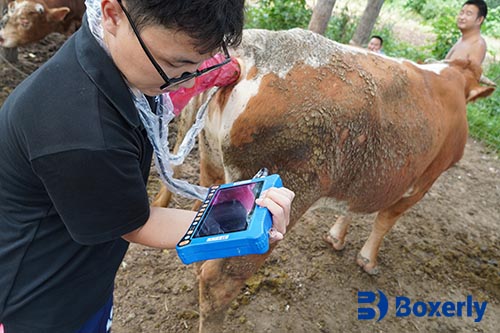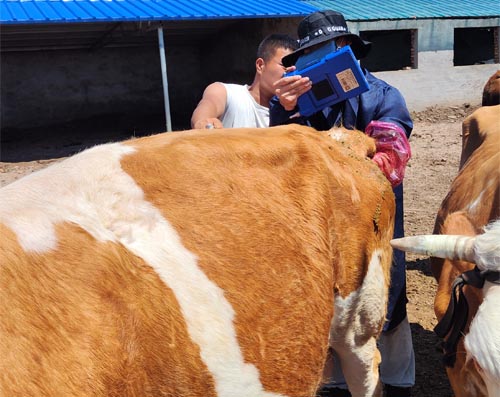In modern livestock farming, especially in remote or pasture-based operations, timely and accurate reproductive monitoring is critical. Farmers need reliable, on-site tools that allow them to make informed decisions about breeding, calving, and herd productivity without the delays or costs of transporting animals to clinics. Field portable ultrasound equipment has emerged as a practical, effective, and non-invasive solution that addresses these challenges head-on. Through real-time imaging of reproductive organs, veterinarians and livestock producers can better manage fertility cycles, detect early pregnancies, and evaluate reproductive health in a wide range of animals.

In this article, I will explain how field portable ultrasound devices are used in reproductive monitoring, reflect on their benefits from an international perspective, and provide practical insights from real-life applications across species.
Reproductive Monitoring on the Farm: A Changing Landscape
Traditionally, reproductive assessments in livestock were performed using rectal palpation or hormonal testing—methods that often required specialized skills, laboratory turnaround times, or caused stress to the animals. With the advancement of portable veterinary ultrasound, however, reproductive diagnostics can now be performed directly in the field with high accuracy and minimal disruption.
Internationally, portable ultrasound use has become mainstream in countries like the United States, Australia, and Germany, where herd sizes are large and veterinary support can be limited in rural areas. These compact devices allow farmers and technicians to make precise decisions regarding breeding timing, pregnancy confirmation, or identifying fertility issues—right in the barn or pasture.
Core Advantages of Field Portable Ultrasound in Reproduction
1. Early and Accurate Pregnancy Detection
One of the most common uses of field ultrasound is confirming pregnancy. In cattle, sheep, pigs, and goats, pregnancy can be detected as early as 25 to 30 days post-breeding. This is significantly earlier than what’s possible with manual palpation or external signs. Early detection allows farmers to identify non-pregnant females and reintroduce them into the breeding program without losing time.
For example, on New Zealand sheep farms, breeders often use portable ultrasound during seasonal breeding to sort pregnant from non-pregnant ewes. This helps optimize nutrition, plan lambing schedules, and reduce feed costs by avoiding overfeeding of open animals.
2. Real-Time Imaging of Reproductive Organs
Portable ultrasound gives real-time images of the uterus and ovaries. This is vital for diagnosing uterine infections, monitoring ovarian follicles, or identifying abnormal conditions such as cysts or fluid accumulation.
In sows, for instance, portable ultrasound is used post-weaning to evaluate whether the uterus has returned to normal, ensuring that the sow is ready to breed again. This shortens the non-productive interval and increases the number of litters per year.
3. Ovulation Monitoring and Synchronization Programs
In AI (artificial insemination) programs, especially in dairy and beef cattle, it is critical to inseminate at the right time. Portable ultrasound allows users to monitor follicular development and detect ovulation, increasing the success rate of insemination. In countries like Canada and the Netherlands, this technology has been instrumental in fine-tuning synchronization protocols and improving conception rates.
4. Stress-Free and Animal-Friendly
Compared to manual palpation or blood sampling, ultrasound is non-invasive and painless. Animals remain calm, and repeat assessments can be performed without risk. This improves animal welfare and reduces the chance of reproductive complications.

Case Applications Across Species
Cattle (Beef and Dairy)
In cow herds, ultrasound is routinely used to monitor the reproductive tract during postpartum recovery, to check for uterine infections, ovarian status, and early pregnancy. In the US, many large dairy operations have adopted weekly ultrasound checks using portable devices to maintain a high reproductive turnover and short calving intervals.
Pigs
In the swine industry, detecting pregnancy in sows early helps reduce non-productive days. With portable ultrasound, farms can evaluate pregnancy in the crate without moving the animal, reducing stress and labor. Danish pig producers use this routinely for accurate herd fertility management.
Sheep and Goats
Because sheep and goats are more sensitive to handling stress, portable ultrasound is especially useful. It allows for quick scanning in the field to determine fetal numbers and viability. Australian sheep farms often scan thousands of ewes in a day using battery-powered ultrasound units mounted on ATVs.
Horses
Equine breeders use ultrasound to evaluate mares for breeding readiness and to identify early pregnancies. With the help of portable scanners, veterinarians can detect twin pregnancies or abnormal uterine structures that would otherwise go unnoticed. This has become a routine part of thoroughbred breeding operations in the UK and Ireland.

Choosing the Right Portable Ultrasound for Reproductive Use
A good reproductive ultrasound system should offer:
High-resolution imaging of soft tissues like ovaries and uterine horns
Waterproof and dustproof housing for rugged farm conditions
Long battery life (6+ hours) for fieldwork
Lightweight, ergonomic design that can be worn or held easily
Compatibility with rectal probes or abdominal probes for different species
Models like the BXL-V50 or similar devices from global manufacturers are frequently mentioned in vet forums for combining portability with clinical-grade performance.
Practical Challenges and Limitations
Despite its advantages, there are a few considerations:
Operator skill: Ultrasound use still requires training to interpret images accurately. Many countries have introduced technician certification programs to support on-farm diagnostics.
Limited resolution in early gestation for small animals: In early stages, especially in small ruminants or pigs, recognizing embryos can be tricky without sufficient resolution.
Cost: Although portable devices are more affordable than stationary ones, upfront cost may still be a barrier for small farms. However, the long-term ROI through improved breeding efficiency often offsets this.
International Perspectives on Use and Acceptance
In the United States, over 70% of large dairies incorporate ultrasound in routine reproductive exams. In Germany and Austria, vet-led AI services increasingly rely on ultrasound for follicle monitoring. Meanwhile, developing regions like parts of Africa and Southeast Asia are beginning to adopt more portable and solar-powered units to improve livestock productivity in remote areas.
The FAO has also highlighted the role of ultrasound in sustainable animal production, especially for reducing the environmental footprint by optimizing herd reproduction and reducing wastage from open animals.
Conclusion
Field portable ultrasound is revolutionizing reproductive monitoring in livestock management. Whether you're running a cattle ranch in Texas, a sheep station in Australia, or a piggery in Denmark, having the ability to assess fertility, pregnancy, and uterine health on the spot means faster decisions, healthier animals, and better productivity.
As more farmers gain access to training and affordable technology, ultrasound will continue to play a central role in improving global livestock efficiency. What was once limited to veterinary clinics is now an essential part of everyday animal husbandry.
Reference Sources
Whitaker, D. A., & Smith, E. (2021). Veterinary Ultrasonography in Food-Producing Animals. Journal of Veterinary Imaging.
Beef Cattle Institute. (2023). Use of Ultrasound for Growth Evaluation in Cattle. https://www.beefcattleinstitute.org/ultrasound-growth
Food and Agriculture Organization (FAO). (2022). Animal Reproduction Technologies for Sustainable Livestock Production. https://www.fao.org/3/cb8033en/cb8033en.pdf
Kuster, C. E., & Taylor, C. (2020). On-Farm Use of Ultrasound in Swine Reproductive Management. Canadian Journal of Animal Science, 100(3), 257–263. https://cdnsciencepub.com/doi/10.1139/cjas-2019-0185
Australian Sheep CRC. (2021). Ultrasound Pregnancy Scanning for Ewe Management. https://www.sheepcrc.org.au/scanning-guide









